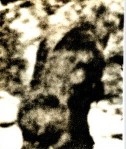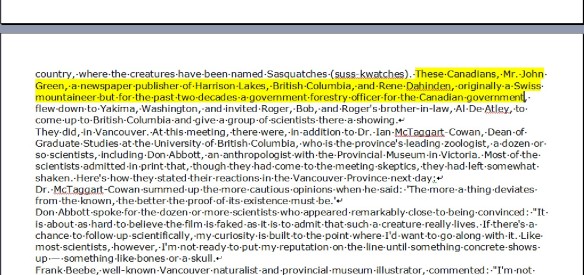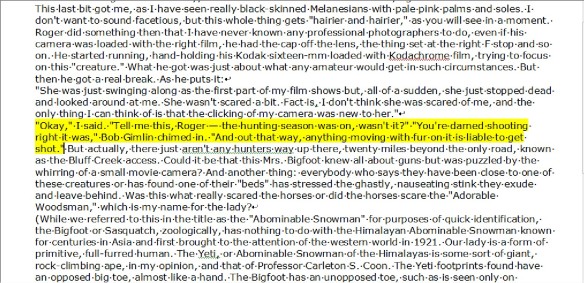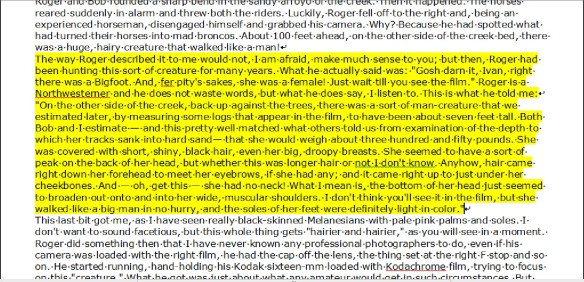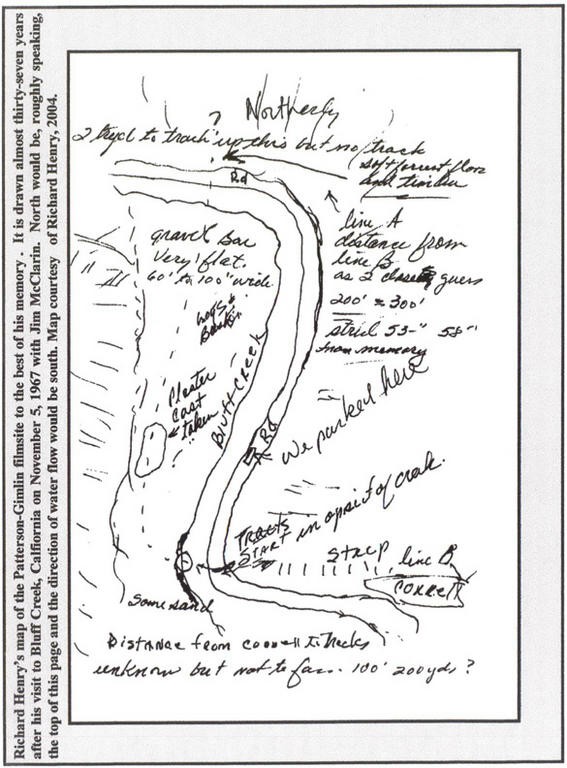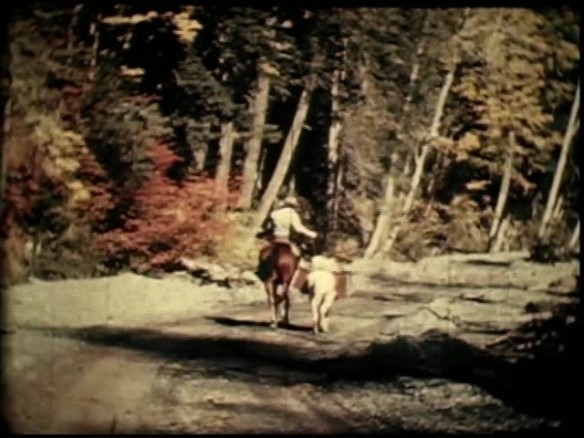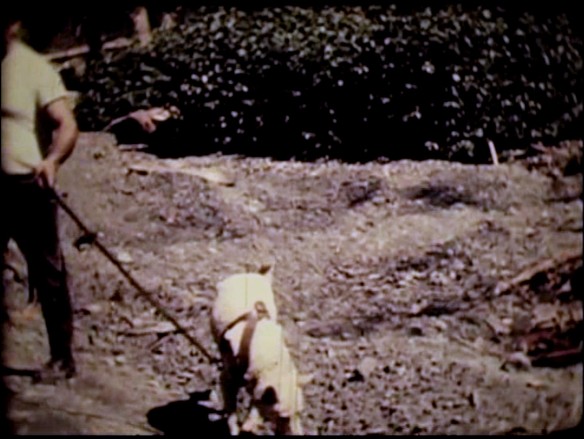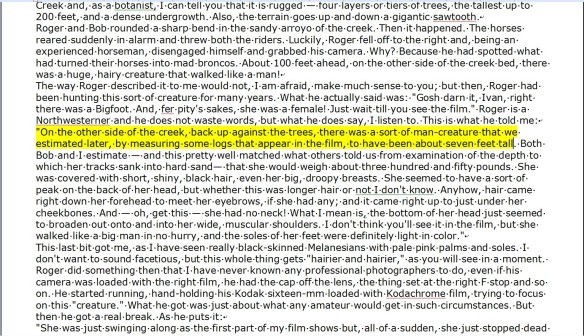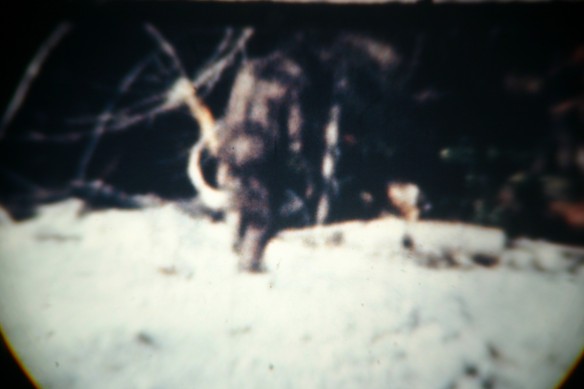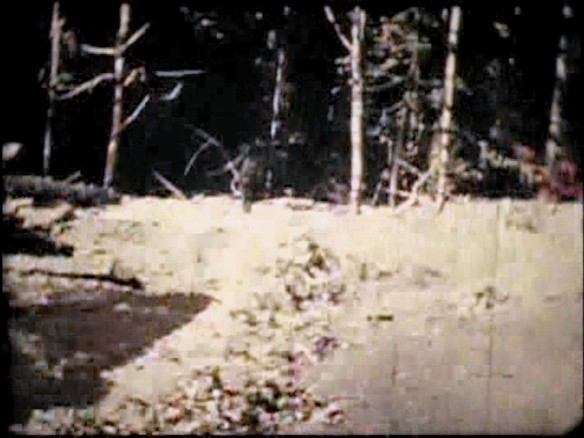The unusual style of walking is often talked about in reference to the Patterson film subject. I have found that this is true. There is a distinctive “wobble” to the knee. The knee turns inward. I caution that this may not necessarily be a trait that all Sasquatch share. Click on the image to animate.
Monthly Archives: September 2011
The Davis Report-Skin and hair
Image
Here’s a clip with the film subject rotating in the sunlight. This clip shows a definite color to the skin and the “patchy” nature of the body hair. A suit…constructed in such a way would be very difficult, if not impossible to make with the technology of the day. Click on the image to animate.

Copyright Patricia Patterson. Film work and stabilization by M.K.Davis. Please do not right click without permission.
The Davis Report-Argosy Magazine, November 1968 Interview with Roger Patterson and Robert Gimlin
Image
This magazine article and interview has been a terrific resource for information and material close to the time of the filming. Argosy had access to the original film and the photos that they published at that time, even though suffering from the dot matrix patterns of magazine printing, were still of superb quality. This blog will likely continue to grow over the next few days as I add images and material from this article by Ivan T. Sanderson. This image has had the moire or the dot matrix greatly reduced to provide a less grainy image. Click on the image to enlarge.
Here is a photo of one of the casts from the filmsite. I thought it a bit odd that it would look so different from the copy that I purchased and that is so popular right now. Do you see anything in this cast that is unusual? Click on the image to enlarge.
Here is the face from the Argosy magazine article. The image has been brightened and contrast boosted. This is not frame 352, but rather 353. You can see the mouth very well, and the left hand is open some. Click on the image to enlarge.
There are some real surprises when reading this article. For instance, I was told, when I first became interested in this subject, that the Canadian Rene’ Dahinden was self employed, and that he recycled lead from a skeet shooting range to finance his Bigfooting efforts. When I read the article, I was surprised to learn that he was a 20 year employee of the Canadian Forestry Service. I am doubtful that Mr. Sanderson got it wrong. He had a sterling reputation as an author, lecturer, and investigator. Here’s an excerpt from the article. Click on the image to enlarge.
The reason that this piques my interest is that “ALL” that Mr. Dahinden did was look for Bigfoot…for many years. When did he have time to be a government employee? Was it possible that the government was financing his search for the Sasquatch?
Here’s another excerpt from the article that quotes Robert Gimlin. Mr. Sanderson was questioning Roger Patterson and his line of questioning invoked an impromptu reply from Mr. Gimlin. Here’s the exchange. Click on the image to enlarge.
Here, Roger talks about his impressions on the height and weight of the Sasquatch, and the gender and hairstyle as well. Click on the image to enlarge.
In the description above he talks about her weight. Notice that he says that others, after examining the tracks on the hard packed sand, put the weight at 350lbs. I wonder what others he was referring to, because not everyone is good at that kind of interpretation. I personally put the Sasquatch at a maximum of 300lbs. I have walked the length and breadth of Bluff Creek in that area and I have yet to find any hard packed sand. I know that there was a road into the film site at that time, which was hardened with lime, for the logging trucks to get the logs out. If that was what they were referring to, then weight estimates based on that should be disregarded as the lime is inconsistently spread and mixed. Here’s a map by Richard Henry, who was in there as early as November of 1967, which shows the road. Click on the image to enlarge.
Here are some photos of the hard packed road in the creek bed. Click on the image to enlarge.
Here’s another photo showing the road. Click on the image to enlarge.
Another thing that I found odd about the testimony is this:
It’s the statement “back up against the trees there was a man-creature”. When the official version of the film begins, the Sasquatch is anything BUT back up against the trees. Here’s a photo from the film’s beginning sequence. Click on the image to enlarge.
Here’s the wide field version. Click on the image to enlarge.
As you can see…the Sasquatch certainly isn’t back up against the trees. Later, when the Sasquatch does get near the trees, her feet are no longer visible in the film. She then bends over, so I wonder how they got an accurate height measurement?
Then there is the “no neck” statement by Patterson. A close look at the film reveals that this is not correct. Click on the image to animate.
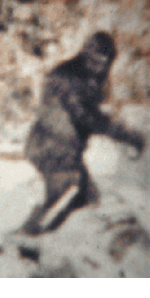
Copyright Patricia Patterson. Film work and stabilization by M.K.Davis. Please do not right click without permission.
Stay tuned for more from this article. M.K.
The Davis Report-Some Surprises When You Look Close
Image
The Patterson film is full of surprises when subjected to close inspection. Here’s an example. Watch the animation as it runs. Click on the image to animate it.
If the sand bar were properly exposed, we could see that this print, or in this case “half print”, is not on level ground but on a spit of sand that pitches it toward the camera. Is this a footprint? Well…it’s in the place where the other foot would likely have been. You be the judge.
The Davis Report-New Technologies
Image
One of the most useful of the new generation of technologies regarding video is stabilization. Youtube is now offering stabilization of video that is posted to their site. Here is a video that I took of the massive Yazoo City tornado that struck my hometown on April 24th, 2010. This tornado, as far as I can find out, is the largest tornado ever caught on camera. Watch the enormous improvement that the stabilization makes in the video. I wonder what the Patterson film would look like if it were so stabilized? Click on the image to run the video.
The Davis Report-Intrinsic Brightness
Image
First of all, as good as the Patterson Sasquatch film is…it is still a rather “low contrast” film. This is why a lot of surface detail is hard to distinguish and why a lot of misinterpretation occurs. Everything that reflects light has its own “intrinsic brightness” levels. Astronomers call this “albedo”. There is much that can be done to enhance the contrast and thus distinguish the tones from one another. Filtration is one. This is done prismatically. A color split, either using glass color filter, or using digital technology to split the colors. An imperfect lens, which is nearly all lenses, will not focus all colors to a single point. Some of the colors remain out of focus and contribute to the over all unsharpness of the image. Removing these colors sharpens the image significantly. The remaining colors in the image can then have contrast boost applied to them. Digitally this would mean that tones that are described mathematically by numbers that are close to the same, can be reassigned numbers that are greater and lesser, to make the tones diverge and boost the contrast. This is not altering the image, it is taking what is already there, and making it more seeable, which is called “enhancement”. Understanding surface brightness and why one part of an image would have a different tone than its surroundings is a prerequisite for film interpretation. In other words, for instance, “Patty’s” head has one tone on the side, and another tone on the crown and down the back of the neck. Why would the film record this as “two” toned. The surface reflectivity changes along the crown of the head and down the back of the neck, mostly due to a marked difference in “curvature” in that area. In other words the curve of the reflective surface changes and thus less light is reflected back to the camera and to the film plane. Now for a general head of hair, this does not usually occur, but if the hair has been bound in some way into a “bunched” arrangement, then it reflects less light back to the camera due to its now “curved” surface. This results in the image recording that area as significantly darker. When the film gives you this tonal divergence, then the divergence can be driven further apart through value reassignment of the two tones and then what’s on the head leaps into view. Here’s an example. On the left is the raw image. On the right is the filtered image. The part that is curved or bunched reflects less light to the camera and appears darker. It is visible from the crown of the head down the back of the neck to the back. Click on the image to enlarge.
Here’s another example. Once again, notice the darker area from the crown of the head…down the back of the neck. Click on the image to enlarge.
Here’s an animated file where each frame is filtered. The hair on the side of the head is significantly long enough to blow in the wind some as she moves forward. Click on the image to animate.

Copyright Patricia Patterson. Film work and stabilization by M.K.Davis. Please do not right click without permission.
In the filtered animation below, the head can be followed in a turn toward the camera and back. When the head is looking away the dark “bunched” hair can be seen. Click on the image to animate.

Copyright Patricia Patterson. Film work and stabilization by M.K.Davis. Please do not right click without permission.
In this full color animated sequence the same dark area down the head and neck to the back can be seen…illuminated by the brilliant sun. Click on the image to animate.

Copyright Patricia Patterson. Film work and stabilization by M.K.Davis. Please do not right click without permission.
The Davis Report-Frame 352
Image
Frame 352 from the original Patterson film event. The highest quality jpeg image there is. There are only a few higher quality versions of this frame but are too big to post here. This photo is only here by the kindness of Patricia Patterson.Click on the image to enlarge, then…click on the image again to enlarge further.
The Davis Report-The Illusion of Knowledge.
Image
The late historian Daniel J. Boorstin once said…”The greatest obstacle to discovery is not ignorance, but the illusion of knowledge.” This remarkable film, I.E. the Patterson Sasquatch film, has served as a vehicle for many such “illusionists.” Early on, it was prevented from being shown in its pristine forms, and thus became the fodder for any, who wanted to suggest the nature of its subject. The prevailing thoughts about the film depended less on what the film actually contained, and more upon the qualifications of the presenters of conjecture. These ones wore their qualifications out on their sleeves and presented themselves as “foremost”, as if they had no peer, and indeed, no peer was allowed. Generations of observers have been the victims of such ones. Poor handling of the film, not by Roger Patterson, but by the people that subsequently came into possession of it, has served to gift us all with a cycle of ignorance, that was born of this “illusion of knowledge.” Good images do not need the power of suggestion to speak to someone. I hope that you recognize what you are seeing here at this site. You are seeing the light of day…and it is illuminating our past. To those who can put aside the 40 plus years of jargon loaded knowledge mongering… these images offer us all a keyhole peek into another world, that perhaps may have once been our own. This film fosters a kind of ambivalence, in a way that no other film can. The film both attracts and repels, and perhaps many of us are afraid for it to be real. Yet…the physics of light and recording media did its job that day, as well as the camera person…and…we are stuck with it, and…my eyes…and your eyes…don’t have the need of much interpretation when the images are as good as they are…presented here. Thank you for stopping by this site. It was built with you in mind, persons who know their own mind… and believe their own eyes. M.K.Davis
The Davis Report-What’s in the left hand?
Image
It should be obvious that there is something of size being carried by or attached in some way to the left arm or hand. Compare to the right hand for size registration. The question is…what is it? Only seconds later it is no longer in the left hand as she raises the left hand into view. Now…what are we looking at? Click on the image to animate.

Copyright Patricia Patterson. Film work and stabilization by M.K.Davis. Please do not right click without permission.
Here’s the file with a built in delay. Click on the image to animate.

Copyright Patricia Patterson. Film work and stabilization by M.K.Davis. Please do not right click without permission.
Here’s an enlargement of the area. Click on the image to animate.

Copyright Patricia Patterson. Film work and stabilization by M.K.Davis. Please do not right click without permission.
Only a few seconds or steps further the left hand is seen to be holding nothing. The size of the left hand is now normal. Click on the image to animate.

Copyright Patricia Patterson. Film work and stabilization by M.K.Davis. Please do not right click without permission.
What happened to the enigmatic object that was there…and then not there? See if you can see it here. What is it? You be the judge. Click on the image to animate.

Copyright Patricia Patterson. Film work and stabilization by M.K.Davis. Please do not right click without permission.
The Davis Report-Images From Behind, From the First Walk Sequence.
Image
The first walk sequence is very violent and shaky. Many people think that there is nothing from that part of the film of any worth. Surprisingly, as much as the camera person is shaking the camera, there are clear photos and clips that can be pulled from that part of the film, with lots of good data. Here’s a clip of several frames from behind. Notice the longer hair coming down the neck and onto the back. Also notice that the ribs show through the skin on the back. Click on the image to animate.

Copyright Patricia Patterson. Film work and stabilization by M.K.Davis. Please do not right click without permission.
What’s this on the left side. Look at the animation above and pay particular attention to the left arm area. Is that something being carried? You be the judge. Click on the image below to enlarge.
Here’s a still from this first walk sequence. Once again, you can see longer hair down the back of the neck, and wrinkled skin over the ribs along the left side. Click on the image to enlarge.
Here’s another still that shows the ripples on the back caused by the ribs. click on the image to enlarge. Once again, the hair shows to be much larger down the back of the neck and onto the back. Click on the image to enlarge.
Notice, with this contrast boost, that the ribs show through the skin quite well along the back. I must say that this look in the first walk sequence does not have the same appearance along the back, as the second walk sequence. I have been unable to find this type of appearance in the second walk sequence. Perhaps this is not the same Sasquatch?. There is a scene change between the two sequences and there is no way to verify by film, how much time elapsed between the two film sequences. We simply do not know if the two sequences contain the same Sasquatch. Click on the image to enlarge.


